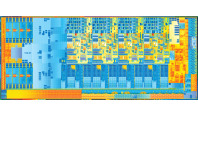Media Benchmarks
Download from: bit-tech.netWe've developed our own suite of benchmarks using real-world and open-source applications in order to simulate how PCs are actually used. The suite comprises an image editing test using Gimp, a video encoding test using Handbrake, and a multi-tasking test using 7-Zip to archive and encrypt a large batch of files, while an HD movie plays in mplayer.
A score of 1,000 means that the test system is as fast as our reference PC, which used a 2.66GHz Intel Core 2 Duo E6750 at stock speed, 2GB of Corsair 1,066MHz DDR2 memory, a 250GB Samsung SpinPoint P120S hard disk and an Asus P5K Deluxe WiFi-AP motherboard. The scoring system is linear, so a system scoring 1,200 points is 20 per cent faster than our reference system. Equally, a system scoring 1,200 is 4 per cent faster than a system scoring 1,150.
Gimp Image Editing
Website: GimpFar from being some kind of pr0n-filtering tool, Gimp is an open-source image editing application - Gimp is an acronym of GNU Image Manipulation Program. Our test simulates how well a PC can manipulate a collection of large digital photos, and to achieve a low time requires a PC with a powerful CPU, plenty of quick memory and efficient access to storage.
Video encoding with Handbrake
Website: HandbrakeWe use the open-source, GPL-licensed, multi-platform, multi-threaded video encoder Handbrake to encode an HD video using the H.264 codec. This primarily tests multi-threaded CPU and memory subsystem performance.
Read our performance analysis.

MSI MPG Velox 100R Chassis Review
October 14 2021 | 15:04









Want to comment? Please log in.